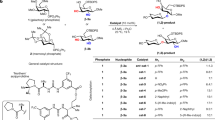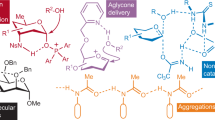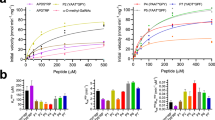Abstract
We report that simple glycoside donors can drastically shift the equilibria of glycosyltransferase-catalyzed reactions, transforming NDP-sugar formation from an endothermic to an exothermic process. To demonstrate the utility of this thermodynamic adaptability, we highlight the glycosyltransferase-catalyzed synthesis of 22 sugar nucleotides from simple aromatic sugar donors, as well as the corresponding in situ formation of sugar nucleotides as a driving force in the context of glycosyltransferase-catalyzed reactions for small-molecule glycodiversification. These simple aromatic donors also enabled a general colorimetric assay for glycosyltransfer, applicable to drug discovery, protein engineering and other fundamental sugar nucleotide–dependent investigations. This study directly challenges the general notion that NDP-sugars are 'high-energy' sugar donors when taken out of their traditional biological context.
This is a preview of subscription content, access via your institution
Access options
Subscribe to this journal
Receive 12 print issues and online access
$259.00 per year
only $21.58 per issue
Buy this article
- Purchase on Springer Link
- Instant access to full article PDF
Prices may be subject to local taxes which are calculated during checkout





Similar content being viewed by others
References
Varki, A. et al. (eds.). Essentials of Glycobiology 2nd edn. (Cold Spring Harbor Laboratory Press, Cold Spring Harbor, New York, USA, 2009).
Thibodeaux, C.J., Melançon, C.E. III & Liu, H. Unusual sugar biosynthesis and natural product glycodiversification. Nature 446, 1008–1016 (2007).
Lairson, L.L., Wakarchuk, W.W. & Withers, S.G. Alternative donor substrates for inverting and retaining glycosyltransferases. Chem. Commun. (Camb.), 365–367 (2007).
Lougheed, B., Ly, H.D., Wakarchuk, W.W. & Withers, S.G. Glycosyl fluorides as substrates for nucleotide phosphosugar-dependent glycosyltransferases. J. Biol. Chem. 274, 37717–37722 (1999).
Zhang, C. et al. Exploiting the reversibility of natural product glycosyltransferase-catalyzed reactions. Science 313, 1291–1294 (2006).
Zhang, C., Albermann, C., Fu, X. & Thorson, J.S. The in vitro characterization of the iterative avermectin glycosyltransferase AveBI reveals reaction reversibility and sugar nucleotide flexibility. J. Am. Chem. Soc. 128, 16420–16421 (2006).
Minami, A., Kakinuma, K. & Eguchi, T. Algycon switch approach toward unnatural glycosides from natural glycoside with glycosyltransferase VinC. Tetrahedron Lett. 46, 6187–6190 (2005).
Modolo, L.V., Escamilla-Treviño, L.L., Dixon, R.A. & Wang, X. Single amino acid mutations of Medicago glycosyltransferase UGT85H2 enhance activity and impart reversibility. FEBS Lett. 583, 2131–2135 (2009).
Zhang, C., Moretti, R., Jiang, J. & Thorson, J.S. The in vitro characterization of polyene glycosyltransferases AmphDI and NysDI. ChemBioChem 9, 2506–2514 (2008).
Quirós, L.M., Carbajo, R.J., Braña, A.F. & Salas, J.A. Glycosylation of macrolide antibiotics: purification and kinetic studies of a macrolide glycosyltransferase from Streptomyces antibioticus. J. Biol. Chem. 275, 11713–11720 (2000).
Okada, T. et al. Bidirectional N-acetylglucosamine transfer mediated by β-1,4-N-acetylglucosaminyltransferase III. Glycobiology 19, 368–374 (2009).
Bolam, D.N. et al. The crystal structure of two macrolide glycosyltransferases provides a blueprint for host cell antibiotic immunity. Proc. Natl. Acad. Sci. USA 104, 5336–5341 (2007).
Williams, G.J., Zhang, C. & Thorson, J.S. Expanding the promiscuity of a natural-product glycosyltransferase by directed evolution. Nat. Chem. Biol. 3, 657–662 (2007).
Williams, G.J., Goff, R.D., Zhang, C. & Thorson, J.S. Optimizing glycosyltransferase specificity via “hot spot” saturation mutagenesis presents a catalyst for novobiocin glycorandomization. Chem. Biol. 15, 393–401 (2008).
Williams, G.J. & Thorson, J.S. A high-throughput fluorescence-based glycosyltransferase screen and its application in directed evolution. Nat. Protoc. 3, 357–362 (2008).
Gantt, R.W., Goff, R.D., Williams, G.J. & Thorson, J.S. Probing the aglycon promiscuity of an engineered glycosyltransferase. Angew. Chem. Int. Ed. 47, 8889–8892 (2008).
Williams, G.J., Yang, J., Zhang, C. & Thorson, J.S. Recombinant E. coli prototype strains for in vivo glycorandomization. ACS Chem. Biol. 6, 95–100 (2011).
Yang, M. et al. Probing the breadth of macrolide glycosyltransferases: in vitro remodeling of a polyketide antibiotic creates active bacterial uptake and enhances potency. J. Am. Chem. Soc. 127, 9336–9337 (2005).
Rexach, J.E., Clark, P.M. & Hsieh-Wilson, L.C. Chemical approaches to understanding O-GlcNAc glycosylation in the brain. Nat. Chem. Biol. 4, 97–106 (2008).
Sakabe, K. & Hart, G.W. O-GlcNAc transferase regulates mitotic chromatin dynamics. J. Biol. Chem. 285, 34460–34468 (2010).
Hanson, S., Best, M., Bryan, M.C. & Wong, C. Chemoenzymatic synthesis of oligosaccharides and glycoproteins. Trends Biochem. Sci. 29, 656–663 (2007).
Weigel, P.H. & DeAngelis, P.L. Hyaluronan synthases: a decade-plus of novel glycosyltransferases. J. Biol. Chem. 282, 36777–36781 (2007).
Bojarová, P. et al. Synthesis of LacdiNAc-terminated glyconjugates by mutant galactosyltransferase—a way to new glycodrugs and materials. Glycobiology 19, 509–517 (2009).
Liu, R. et al. Chemoenzymatic design of heparin sulfate oligosaccharides. J. Biol. Chem. 285, 34240–34249 (2010).
Lau, K. et al. Highly efficient chemoenzymatic synthesis of β1–4-linked galasctosides with promiscuous bacterial β1–4-galactosyltransferases. Chem. Commun. (Camb.) 46, 6066–6068 (2010).
Maccioni, H.J.F., Quiroga, R. & Ferrari, M.L. Cellular and molecular biology of glycosphingolipid glycosylation. J. Neurochem. 117, 589–602 (2011).
Rupprath, C., Schumacher, T. & Elling, L. Nucleotide deoxysugars: essential tools for the glycosylation engineering of novel bioactive compounds. Curr. Med. Chem. 12, 1637–1675 (2005).
Thibodeaux, C.J., Melançon, C.E. III & Liu, H. Natural-product sugar biosynthesis and enzymatic glycodiversification. Angew. Chem. Int. Ed. 47, 9814–9859 (2008).
Yang, J., Hoffmeister, D., Liu, L., Fu, X. & Thorson, J.S. Natural product glycorandomization. Bioorg. Med. Chem. 12, 1577–1584 (2004).
Takahashi, H., Liu, Y. & Liu, H. A two-stage one-pot enzymatic synthesis of TDP-l-mycarose from thymidine and glucose-1-phosphate. J. Am. Chem. Soc. 128, 1432–1433 (2006).
Rupprath, C., Kopp, M., Hirtz, D., Muller, R. & Elling, L. An enzyme module system for in situ regeneration of deoxythymidine 5′-diphosphate (dTDP)-activated deoxy sugars. Adv. Synth. Catal. 349, 1489–1496 (2007).
Timmons, S.C., Mosher, R.H., Knowles, S.A. & Jakeman, D.L. Exploiting nucleotidylyltransferases to prepare sugar nucleotides. Org. Lett. 9, 857–860 (2007).
Wagner, G.K., Pesnot, T. & Field, R.A. A survey of chemical methods for sugar-nucleotide synthesis. Nat. Prod. Rep. 26, 1172–1194 (2009).
Ko, H. et al. Molecular recognition in the P2Y14 receptor: probing the structurally permissive terminal sugar moiety of uridine-5′-diphosphoglucose. Bioorg. Med. Chem. 17, 5298–5311 (2009).
Losey, H.C. et al. Incorporation of glucose analogs by GtfE and GtfD from the vancomycin biosynthetic pathway to generate variant glycopeptides. Chem. Biol. 9, 1305–1314 (2002).
Fu, X. et al. Antibiotic optimization via in vitro glycorandomization. Nat. Biotechnol. 21, 1467–1469 (2003).
Kahne, D., Leimkuhler, C., Lu, W. & Walsh, C. Glycopeptide and lipoglycopeptide antibiotics. Chem. Rev. 105, 425–448 (2005).
Schitter, G. & Wrodnigg, T.M. Update on carbohydrate-containing antibacterial agents. Expert Opin. Drug Discov. 4, 315–356 (2009).
Wagner, G.K. & Pesnot, T. Glycosyltransferases and their assays. ChemBioChem 11, 1939–1949 (2010).
Kittl, R. & Withers, S.G. New approaches to enzymatic glycoside synthesis through directed evolution. Carbohydr. Res. 345, 1272–1279 (2010).
Pesnot, T., Palcic, M.M. & Wagner, G.K. A novel fluorescent probe for retaining galactosyltransferases. ChemBioChem 11, 1392–1398 (2010).
Romero, P.A. & Arnold, F.H. Exploring protein fitness landscapes by directed evolution. Nat. Rev. Mol. Cell Biol. 10, 866–876 (2009).
Williams, G.J., Gantt, R.W. & Thorson, J.S. The impact of enzyme engineering upon natural product glycodiversfication. Curr. Opin. Chem. Biol. 12, 556–564 (2008).
Hancock, S.M., Vaughan, M.D. & Withers, S.G. Engineering of glycosidases and glycosyltransferases. Curr. Opin. Chem. Biol. 10, 509–519 (2006).
Zhang, B. et al. Golgi nucleotide sugar transporter modulates cell wall biosynthesis and plant growth in rice. Proc. Natl. Acad. Sci. USA 108, 5110–5115 (2011).
Dickmanns, A. et al. Structural basis for the broad substrate range of the UDP-sugar pyrophosphorylase from Leishmania major. J. Mol. Biol. 405, 461–478 (2011).
Acknowledgements
This manuscript is dedicated to the late C. Richard Hutchinson for his pioneering contributions to engineered natural product glycosylation. We thank the School of Pharmacy Analytical Instrumentation Center (University of Wisconsin–Madison) for analytical support and G.J. Williams (North Carolina State University) for materials and helpful discussion. R.W.G. is an American Foundation for Pharmaceutical Education Pre-Doctoral Fellow. J.S.T. is a University of Wisconsin H.I. Romnes Fellow and holds the Laura and Edward Kremers Chair in Natural Products. This work was supported by US National Institutes of Health grant AI52218.
Author information
Authors and Affiliations
Contributions
R.W.G., P.P.-P. and J.S.T. contributed to the experimental design. R.W.G., P.P.-P. and W.J.C. performed all experimental work. R.W.G., P.P.-P. and J.S.T. wrote and edited the manuscript.
Corresponding author
Ethics declarations
Competing interests
J.S.T. is a co-founder of Centrose (Madison, Wisconsin, USA).
Supplementary information
Supplementary Text and Figures
Supplementary Methods and Supplementary Results (PDF 15098 kb)
Rights and permissions
About this article
Cite this article
Gantt, R., Peltier-Pain, P., Cournoyer, W. et al. Using simple donors to drive the equilibria of glycosyltransferase-catalyzed reactions. Nat Chem Biol 7, 685–691 (2011). https://doi.org/10.1038/nchembio.638
Received:
Accepted:
Published:
Issue Date:
DOI: https://doi.org/10.1038/nchembio.638
This article is cited by
-
Catalytic flexibility of rice glycosyltransferase OsUGT91C1 for the production of palatable steviol glycosides
Nature Communications (2021)
-
Exploiting the Reversibility of GTBP1 Catalyzed One-pot Reactions for the Synergistical Synthesis of Ponasterone A and Phenolic Glycosides
Biotechnology and Bioprocess Engineering (2021)
-
Effects of glycosylation on the bioactivity of rapamycin
Applied Microbiology and Biotechnology (2020)
-
Engineering a Carbohydrate-processing Transglycosidase into Glycosyltransferase for Natural Product Glycodiversification
Scientific Reports (2016)
-
Recent developments in the enzymatic O-glycosylation of flavonoids
Applied Microbiology and Biotechnology (2016)



